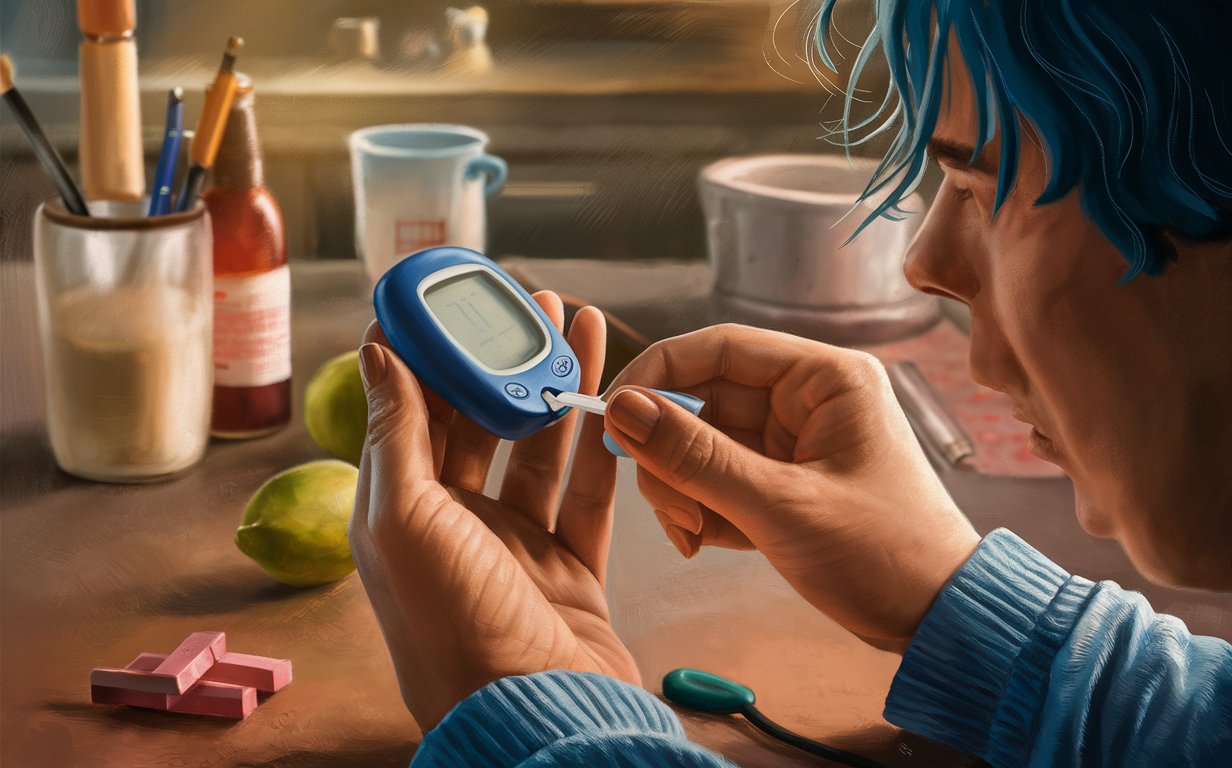Last Updated on August 7, 2024 by Alexander Sennuga
Are you in need of immediate relief from high blood sugar? Get ready to learn powerful strategies to help reduce blood sugar level immediately.
High blood sugar, or hyperglycemia, can lead to serious health complications if left unchecked. It may cause damage to blood vessels, nerves, and organs over time.
Swift action to lower blood sugar levels is crucial for maintaining overall health and preventing long-term issues associated with diabetes.
Stay tuned for life-changing advice ahead.
1. Hydrate Properly

Proper hydration is crucial when looking to manage and reduce blood sugar levels effectively. When it comes to how to reduce blood sugar levels immediately, hydration plays a key role in maintaining overall health and ensuring glucose levels stay in a safer range.
Here’s how you can hydrate properly to help reduce your blood sugar quickly:
The Role of Water in Blood Sugar Management
Water helps the kidneys to flush out excess sugar through urine. Staying hydrated ensures your kidneys function at their best, aiding in the excretion of surplus glucose and thus helping to lower blood sugar levels.
How Much Water Should You Drink?
The general recommendation for water intake is about 8 cups (64 ounces) a day. However, individual needs can vary based on body size, activity level, and medical conditions. When managing high blood sugar, you may need to drink more. Aim for clear, pale urine as a sign of adequate hydration.
Avoid Sugary Drinks
While staying hydrated is important, be cautious to avoid sugary drinks. Beverages like soda, fruit juices, and energy drinks can spike blood sugar levels instead of helping to lower them. Stick to water, herbal teas, and other sugar-free options.
Benefits of Adding Electrolytes
In some cases, adding electrolytes to your water can be beneficial, especially if you’re losing a lot of fluids due to high blood sugar levels. Electrolyte solutions or low-sugar sports drinks can help maintain a proper balance of minerals in your body.
Tips for Staying Hydrated
- Carry a Water Bottle: Always have a water bottle with you, and take sips regularly throughout the day.
- Set Reminders: Use phone alarms or apps to remind you to drink water.
- Flavor It Naturally: If you find plain water boring, infuse it with slices of lemon, cucumber, or mint for a refreshing taste without added sugars.
- Monitor Your Intake: Keep track of how much water you drink daily to ensure you meet your hydration goals.
Proper hydration can help lower blood sugar levels by up to 10% in some individuals.
2. Choose Quick-Acting Fibers

When it comes to managing and reducing blood sugar levels quickly, incorporating quick-acting fibers into your diet can be highly effective. Quick-acting fibers help manage glucose levels by slowing down the absorption of sugar. Here’s how to reduce blood sugar levels immediately by choosing the right types of fibers:
Understanding Quick-Acting Fibers
Quick-acting fibers, also known as soluble fibers, dissolve in water to form a gel-like substance in your digestive system. This gel slows the absorption of sugar into the bloodstream, leading to more stable blood sugar levels.
Types of Quick-Acting Fibers
- Oats and Oat Bran: Rich in beta-glucan, a type of soluble fiber, oats can significantly lower blood sugar levels.
- Psyllium Husk: Often found in fiber supplements, psyllium husk is known for its potent blood sugar-lowering effects.
- Chia Seeds: These tiny seeds swell up and form a gel when mixed with liquid, providing a good dose of soluble fiber.
- Legumes: Beans, lentils, and peas are high in soluble fibers that slow down sugar absorption.
How to Incorporate Quick-Acting Fibers into Your Diet
- Breakfast Options: Start your day with a bowl of oatmeal topped with chia seeds or a fiber-rich smoothie.
- Supplements: Consider adding a psyllium husk supplement to a glass of water or juice.
- Snacks: Enjoy hummus (made from chickpeas) with some raw vegetables or a fiber-packed granola bar.
- Meals: Add beans or lentils to salads, soups, and stews to enhance fiber content.
Benefits of Quick-Acting Fibers for Blood Sugar Management
Quick-acting fibers not only help how to reduce blood sugar levels immediately but also offer several other health benefits:
- Improved Digestion: Fiber aids in smoother digestion and can prevent constipation.
- Heart Health: Soluble fibers can lower cholesterol levels, reducing the risk of heart disease.
- Satiety: Fiber makes you feel fuller for longer, which helps in weight management, indirectly benefiting blood sugar control.
Tips for Maximizing the Benefits
- Stay Hydrated: Drinking plenty of water helps the fiber move through your digestive system effectively.
- Gradual Increase: Start adding fibers to your diet gradually to avoid digestive discomfort.
- Combine with Protein: Pair high-fiber foods with proteins to further stabilize blood sugar levels.
3. Engage in Light Exercise

Engaging in light exercise is one of the most effective and immediate methods to help bring down high blood sugar levels. Physical activity facilitates glucose uptake by muscles, thus lowering blood sugar quickly and naturally. Here’s how you can incorporate light exercise into your routine to manage blood sugar levels effectively.
How Exercise Affects Blood Sugar
When you exercise, your muscles use glucose for energy, which helps decrease the amount of sugar in your bloodstream. Light exercises are particularly beneficial because they are easy to do and can be performed almost anywhere, making them an excellent option for immediate blood sugar management.
Types of Light Exercises
- Walking: A 15-30 minute brisk walk can quickly lower blood sugar levels. Walking is a low-impact activity suitable for most people.
- Stretching: Gentle stretching exercises can improve blood circulation and help reduce glucose levels.
- Yoga: Practicing yoga combines physical activity with stress reduction, both of which can help manage blood sugar.
- Cycling: Riding a stationary bike or a real one engages large muscle groups, effectively lowering blood sugar.
How to Incorporate Light Exercise into Your Routine
- Post-Meal Walks: Taking a walk after meals can be particularly effective in reducing postprandial (after meals) blood sugar spikes.
- Short Exercise Sessions: Even short, 5-10 minute bouts of exercise spread throughout the day can make a significant difference.
- Use Breaks Wisely: Use work or study breaks to do a few light exercises, such as stretching or walking around your home or office.
- Home Workouts: Simple bodyweight exercises like squats, leg lifts, or seated marches can be done at home without any equipment.
Benefits of Light Exercise for Blood Sugar Management
Engaging in light exercise not only helps how to reduce blood sugar levels immediately but also offers numerous other health benefits:
- Improved Insulin Sensitivity: Regular light exercise can make your body more responsive to insulin, helping to control blood sugar long-term.
- Weight Management: Physical activity can aid in weight loss or maintenance, which is crucial for managing blood sugar levels.
- Enhanced Mood: Exercise releases endorphins, which can improve your mood and reduce stress, further benefiting blood sugar levels.
Tips for Maximizing the Benefits
- Stay Consistent: Regular, daily exercise can provide the most benefits for blood sugar management.
- Listen to Your Body: Always pay attention to your body’s signals. If you feel dizzy or overly fatigued, it’s important to rest.
- Stay Hydrated: Drink plenty of water before, during, and after exercise to stay hydrated and support overall health.
- Pair with a Balanced Diet: Combining exercise with a diet rich in fiber, lean proteins, and healthy fats can optimize blood sugar control.
4. Control Carb Intake

Managing carbohydrate intake is crucial when you need to reduce blood sugar level immediately. Carbohydrates directly affect blood sugar since they break down into glucose during digestion. Here’s how to control your carb intake effectively to help reduce blood sugar levels immediately.
Understanding Carbohydrates
Carbohydrates are found in many different types of foods, including grains, fruits, vegetables, and dairy products. While they are an essential source of energy, different types of carbs affect blood sugar in various ways. Simple carbs (found in sugary foods and drinks) can cause rapid spikes, whereas complex carbs (found in whole grains and vegetables) are digested more slowly.
Steps to Control Carb Intake
Choose Low-GI Foods:
- The Glycemic Index (GI) measures how quickly a carbohydrate-containing food raises blood sugar levels. Opt for low-GI foods like non-starchy vegetables, legumes, and whole grains to maintain more stable glucose levels.
Portion Control:
- Even healthy carbs can raise blood sugar if consumed in large quantities. Use portion control to manage the amount you’re eating. For example, limit servings of starchy vegetables like potatoes and grains like rice.
Pair Carbs with Protein and Fat:
- Combining carbohydrates with proteins and healthy fats can slow down sugar absorption, leading to more gradual changes in blood sugar levels. For instance, pair an apple with almond butter or add nuts to your oatmeal.
Avoid Sugary Drinks and Snacks:
- Sugary drinks and snacks cause rapid spikes in blood sugar. Replace them with water, herbal teas, or low-GI fruits and snacks.
Read Labels:
- Be mindful of food labels to check for hidden sugars and high-carb ingredients that could affect your blood sugar.
Benefits of Controlled Carb Intake for Blood Sugar Management
Controlling your carb intake is not only an effective strategy for how to reduce blood sugar level immediately, but it also offers long-term benefits:
- Stable Energy Levels: By avoiding quick spikes and crashes, you’ll experience more consistent energy levels throughout the day.
- Improved Insulin Sensitivity: Lower and more stable blood sugar levels can enhance your body’s sensitivity to insulin over time.
- Better Weight Management: Controlled carb intake can assist in weight loss or maintenance, which is beneficial for blood sugar control.
Practical Tips for Implementing Carb Control
- Plan Your Meals: Prepare balanced meals ahead of time that include a controlled amount of carbs, alongside proteins and healthy fats.
- Track Your Intake: Use a food diary or an app to track your carb intake and monitor its effect on your blood sugar levels.
- Start Gradually: If reducing carbs is new to you, make gradual changes rather than drastic cuts to allow your body to adjust.
- Snack Wisely: Opt for low-carb snacks such as nuts, seeds, cheese, or raw vegetables instead of carb-heavy options.
5. Manage Stress Levels

Stress can have a significant impact on your blood sugar levels, often causing them to spike. Learning how to manage stress effectively is a crucial step in understanding how to reduce blood sugar level immediately. Here’s how you can take control of your stress to better manage your blood sugar.
The Link Between Stress and Blood Sugar
When you’re under stress, your body releases hormones like cortisol and adrenaline. These hormones can trigger the liver to release stored glucose, leading to a rapid increase in blood sugar levels. Chronic stress can also contribute to insulin resistance, making it harder for your body to regulate blood sugar effectively.
Strategies to Manage Stress
Practice Relaxation Techniques:
- Engage in activities like deep breathing, meditation, or yoga to help calm your mind and body.
Get Enough Sleep:
- Aim for 7-9 hours of quality sleep each night, as sleep deprivation can increase stress and disrupt blood sugar control.
Exercise Regularly:
- Physical activity not only helps lower blood sugar but also releases endorphins that can reduce stress.
Prioritize Self-Care:
- Make time for activities you enjoy, such as reading, listening to music, or spending time in nature.
Seek Social Support:
- Connecting with friends, family, or a support group can help you manage stress and feel more supported.
Limit Caffeine and Alcohol:
- Excessive consumption of these substances can exacerbate stress and negatively impact blood sugar levels.
Benefits of Stress Management for Blood Sugar Control
Effectively managing stress can have immediate and long-term benefits for your blood sugar levels:
- Reduced Blood Sugar Spikes: Lowering stress can help prevent the rapid rise in blood sugar caused by stress hormones.
- Improved Insulin Sensitivity: Chronic stress can contribute to insulin resistance, and managing stress can help improve insulin sensitivity over time.
- Better Overall Health: Stress management techniques can also benefit your cardiovascular health, mental well-being, and overall quality of life.
Tips for Implementing Stress Management Strategies
- Start Small: Incorporate stress-reducing activities into your daily routine, even if it’s just for a few minutes at a time.
- Find What Works for You: Experiment with different stress management techniques to discover what resonates best with your personal preferences and lifestyle.
- Seek Professional Support: If you’re struggling to manage stress on your own, consider working with a therapist or counselor who can provide personalized guidance.
- Be Patient and Persistent: Reducing stress takes time and practice, but the benefits for your blood sugar and overall health are well worth the effort.
Conclusion
Implementing these five quick tips can help lower blood sugar levels rapidly.
However, it’s important to remember that consistent blood sugar monitoring and management are key to long-term health.
Regular check-ups with healthcare providers and adherence to prescribed treatments remain crucial in managing blood sugar effectively.

